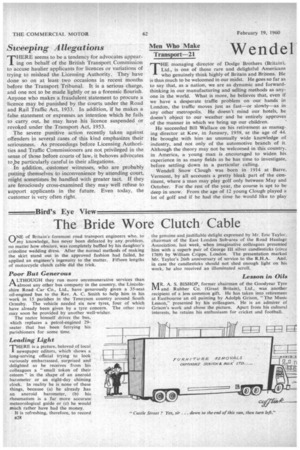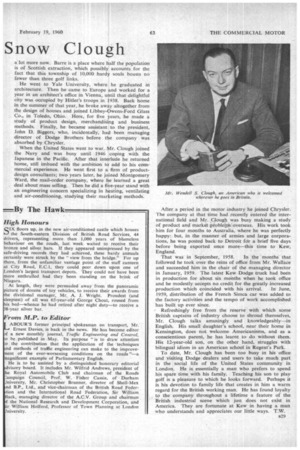The Bride Wore Clutch Cable
Page 32

Page 33

If you've noticed an error in this article please click here to report it so we can fix it.
By The Hawk
ONE of Britain's foremost road transport engineers who, to my knowledge, has never been defeated by any ,problem. no matter how obscure, was completely baffled by his daughter's crinoline wedding dress. After the normal methods of making the skirt stand out in the approved fashion had failed, he applied an engineer's ingenuity to the matter. Fifteen lengths of motorcycle clutch cable did the trick.
Poor But Generous
A LTHOUGH they run more unremunerative services than almost any other bus company in the country, the Lincolnshire Road Car Co., Ltd., have generously given a 35-seat oil-engined bus to the Rev. A. C. Smith to help him in his work in 15 parishes in the Tennyson country around South Ormsby. The vehicle needed six new tyres, four of which have already been given by a tyre concern. The other two may soon be provided by another well-wisher.
The rector himself drives the bus, Nhich replaces a petrol-engined 29seater that has been ferrying his parishioners for some time.
Leading Light
THERE is a picture, beloved of local
newspaper editors, which shows a long-serving official trying to look variously embarrassed, surprised and delighted as he receives from his colleagues a "small token of their esteem" in the shape of an aneroid barometer or an eight-day chiming clock. In reality he is none of these things, because (a) he already has an aneroid barometer, (b) his rheumatism is a far more accurate meteorological guide or (c) he would much rather have had the money.
It is refreshing, therefore, to record B28
the genuine and justifiable delight expressed by Mr. Eric Taylor, chairman of the East London Sub-area of the Road Haulage Association, last week, when imaginative colleagues presented him with a superb pair of George III silver candlesticks (circa 1769) by William Cripps, London. The presentation marked Mr. Taylor's 26th anniversary of service to the R.H.A. And, in case the candlesticks should not shed enough light on his work, he also received an illuminated scroll.
Lesson in Oils
up. A. S. BISHOP, former chairman of the Goodyear Tyre IVI and Rubber Co. (Great Britain), Ltd., was another recipient of a less common gift. He has taken into retirement at Eastbourne an oil painting by Adolph Grison, "The Music Lesson," presented by his colleagues. He is an admirer of Orison's work and chose the picture. Apart from his cultural interests, he retains his enthusiasm for cricket and football.
High Honours
QIX floors up, in the new air-conditioned castle which houses
the South-eastern Division of British Road Services, 44 drivers, representing more than 1,000 years of blameless behaviour on the roads, last week waited to receive their bronze and silver bars. If they appeared unimpressed by the safe-driving records they had achieved, these hardy annuals certainly were struck by the "view from the bridge." For up there, from the unfamiliar vantage point of the staff canteen at City Road, E.C.1, they could peer down upon one of London's largest transport depots. They could not have been more enthralled had they been standing on the brink of Niagara.
At length, they were persuaded away from the panoramic
picture of dozens of toy vehicles, to receive their awards from he divisional manager, Mr. A. I. Wright. Proudest (and leepiest) of all was 65-year-old George Choat, roused from is bed—whence he had retired after night duty—to receive a 8-year silver bar.
rum M.P. to Editor
ABOUR'S former principal spokesman on transport, Mr. Ernest Davies, is back in the news. He has become editor f a new monthly journal, Traffic Engineering and Control,
o he published in May. Its purpose "is to draw attention o the contribution that the application of the techniques nd methods of traffic engineering can make to the improveeat of of the ever-worsening conditions on the roads "—a agnificent example of Parliamentary English.
He is to be assisted by a distinguished honorary editorial dvisory board. It includes Mr. Wilfrid Andrews, president of he Royal Automobile Club and chairman of the Roads ampaign Council, Prof. W. Fisher Cassie, of Durham niversity, Mr. Christopher Brunner, director of Shell-Mex nd B.P., Ltd., and vice-chairman of the British Road Federtion and the International Road Federation, Sir William lack, managing director of the A.C.V. Group and chairman the National Research and Development Corporation, and 'r William Holford, Professor of Town Planning at London niversity.








































































































